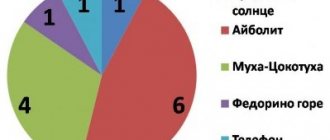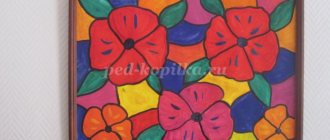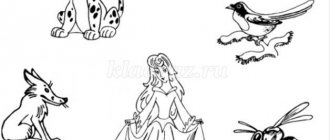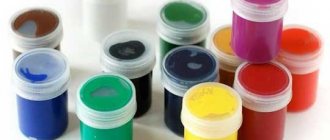MAGAZINE Preschooler.RF
Abstract of GCD on the topic “Cookware”Integration of educational areas: “Speech development” , “Cognitive development” , “Social and communicative development” , “Physical development” , “Artistic and aesthetic development”
Zodachi
- Expand children's understanding of the variety of dishes and their qualities; manufacturing materials. (Cognitive development).
- Continue to develop speech hearing; practice determining the position of sounds in a word; continue to learn how to make sentences with the conjunction a.
(Speech development).
3. Clarify and expand vocabulary on the topic “Tableware” : glass, porcelain, disposable, candy dish, bread box, cracker bowl, butter dish, milk jug, herring bowl. Introduce the formation of the compound word samovar. (Speech development)
4. To develop general and fine motor skills of pupils, the ability to combine movements with
speech. (Physical development).
5. Foster a caring attitude towards utensils (social and communicative development).
6. Continue to develop the ability to perform a game task in pairs, to coordinate your actions with the actions of your partner. (Social and communicative development).
7. Arouse an emotional mood from listening to a piece of music.
(Artistic and aesthetic development)
Materials and equipment: sets of dishes for different purposes from various materials: tea, coffee, dining, children's, plastic, porcelain, paper, metal, wood; rebus, markers; audio recording.
Preliminary work: reading a fairy tale by K.I. Chukovsky "Fedorino's grief"
GCD move
Organizational moment: Game “Give a smile to a friend”
Educator: guys, let's gather in a circle and pass on our smiles to each other. (a game)
Educator: I have a rebus for you - an encrypted word, if we guess it, we will find out what kind of object lies in our surprise chest.
dishes
In the first cell you need to write the letter that comes first in the surname of our boys Maxim Pilipenko and Maxim Pritvorov;
In the second cell - the letter that is the 4th in the name Veronica;
In the third - the fifth letter in the name Miroslav;
In the fourth - the third letter of Sofia Saulich's surname;
In the fifth - the third letter in the name Vadim;
The sixth is the last letter in the name Veronica.
(children guess)
Educator: Well done! Now let's see what's in our chest. That's right, these are dishes. Why do we need dishes? (to cook, eat, store food)
(There is a knock on the door. A dirty and disheveled Fedora comes in to the music. She cries)
Educator: guys, have you guessed who it is? That's right, this is Fedora from K. Chukovsky's fairy tale “Fedorino's grief” . Tell us Fedora, what are you upset about?
Fedora: Oh woe, woe is me, all the dishes left me.
Educator: Guys, do you know why Fedora left the dishes? Of course, dishes need to be kept clean and always put back in their place. Go, put yourself in order and the dishes will definitely come back to you.
(Fedora is still crying)
Fedora: I feel sorry for the dishes, they will break. Saucers, saucers, rush along the street. They bump into glasses... ding. And the glasses... ding - they break.
Educator: Guys, what kind of dishes can break? (made of glass, crystal, porcelain, clay). How should you handle it so that it doesn’t break? (carefully, carefully). What kind of dishes do not break (metal, wood, plastic, paper).
Fedora: ok guys, I’ll try to return the dishes.
Educator: Well, you and I are going to an exhibition of dishes.
(children look at dishes: tea, kitchen, children's, toys, made of various materials - wood, porcelain, glass, clay, plastic, metal.
A didactic game is being held : “What is which?”
Educator: Now we need to sort all the dishes. What do we call the teaware? coffee; for Game; for children; for cooking food?
(children name and lay out sets of dishes on napkins - tea set, coffee set; kitchen, children's, dining, disposable tableware)
Phys. minute: Let's play.
Here is a large glass teapot (puff up your tummy)
He is a very important boss (one hand on his belt, the other - to depict the spout of a teapot).
Here are the porcelain cups (sat down, hands on the belt).
Here are porcelain saucers (they are spinning, drawing a circle with their hands).
Just knock and they will break.
Here are the silver spoons (they stretched their hands up and closed them).
Here is a plastic tray, he brought us dishes.
Educator: Guys, take one piece of utensils that you liked the most and tell us about it.
(Children choose one piece of utensils and write a descriptive story.
Example: this is a teapot, it is made of metal, that means it is metal. It has a handle, a spout, a lid, a bottom, and walls. It boils water.)
The teacher draws attention to the large box.
Educator: here are utensils whose names contain food products. You must guess what these items are. We will put candy in a... candy bowl, butter in a... butter dish, bread in a bread box, herring in a... herring bowl, crackers in a rusk bowl, milk in a... milk jug, sugar in a sugar bowl.
(Children look at the dishes they guessed)
Educator: Please name the objects whose names contain the sound s and s.
How are these sounds similar and different?
(There is a knock on the door, a transformed Fedora comes in, holding a samovar.)
Fedora: Thank you guys, I did everything as you advised me: I washed myself, combed my hair and all the dishes came back to me. And for this I want to thank you. Look what I brought you! Do you know what this is? (samovar) And what two words are hidden in the word samovar? (he cooks it himself). It was called that because in ancient times they not only drank tea in a samovar, but also cooked soup and porridge. I also want to treat you to all sorts of sweets and give you delicious tea.
Educator: you are Fedorushka, sit down, relax, the guys will teach you how to make sentences with the conjunction a.
(Children are divided into pairs and choose sweets to taste; make sentences.
For example: I will drink tea with jam, and I will drink tea with sweets).
Fedora: you guys are great, you do it cleverly.
(Summarizing)
Educator: guys, tell Fedora what kind of dishes there are and what they are intended for (Holding a tea party)
| Next > |
Summary of OOD on familiarization with the outside world on the topic: “Utensils”
Summary of OOD on familiarization with the outside world
on the topic: "Dishes"
Author:
teacher
Mikolyan Ksenia Andreevna
Target:
to form children’s understanding of the types of dishes; teach how to use utensils in accordance with their intended purpose.
Tasks:
Social and communicative development:
cultivate a friendly attitude towards peers, the ability to listen to each other; teach children to be attentive to loved ones and take care of them.
Cognitive development:
to develop in children the ability to distinguish and name utensils; learn to group and combine utensils according to similar characteristics (according to their purpose).
Speech development:
develop children’s ability to answer questions clearly and completely; develop speaking skills; enrich children's vocabulary.
Physical development:
to form basic healthy lifestyle skills in preschoolers.
Artistic and aesthetic development:
strengthen children’s ability to decorate dishes using lines, strokes, dots, circles and other familiar elements; develop aesthetic perception, independence, initiative.
Preliminary work with children:
monitoring the serving of food and washing dishes; conversation about the use of dishes, what they are made of; reading the work of K. Chukovsky “Fedorino’s grief”.
Progress of the lesson:
Educator: Guys, do you like to solve riddles?
Children: children's answers.
Educator: Then listen to the riddles and tell the answers.
Who doesn’t have the answer - What should I cook my lunch in? There is a clean thing on the stove. To cook the soup, you need... (saucepan)
Made of iron, cast iron - With a long handle and round, You can fry on it without difficulty! What's this? (Pan)
If you want tea, choose any one! Here they are - fatties. Who are they? (Mugs)
In order for everyone to have dinner together, what should be put on the table? Deep or shallow For food... (Plate)
He puffs like a steam locomotive, holding his nose up. Make some noise, calm down - Invite the seagull to drink. (Kettle)
A boat is floating on my plate. I put the boat of food into my mouth. (Spoon)
If sharpened well, it cuts everything very easily - Bread, potatoes, beets, meat, Fish, apples and butter. (Knife)
Educator: Well done guys, you guessed all the riddles.
-Tell me guys, what were the riddles about?
Children: children's answers.
Educator: What can you call it, in one word?
- What other dishes do you know? -What are the dishes for? — Is it possible to live without dishes?
Children: children's answers.
Educator: Let's listen to a poem about what we would do if there were no dishes: If there were no dishes, We would have had a very bad time. We would immediately turn from people into savages: We would take the meat with our hands, we would tear it with our teeth, we would drink water in the river, or in a dirty stream. Fortunately, various utensils help us everywhere: They put food on it, they eat and drink from it. They store food in it: Cheese and butter, bread and fruit... Hundreds of dishes are prepared in it - Boiled, fried and baked! Educator: That's how much we need dishes.



